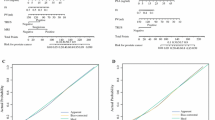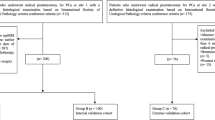Abstract
Background
Debate persists regarding whether MRI should be used routinely for preoperative evaluation of prostate cancer.
Objective
The aim is to assess the role of prostatic magnetic resonance imaging (MRI) and other preoperative data in extra-prostatic extension (EPE) evaluation.
Patients and methods
From 2000 to 2013, 1743 patients operated for radical prostatectomy had a preoperative MRI. Age, clinical stage with digital rectal exam (DRE), PSA, prostate weight, biopsy, MRI and pathological findings of the surgical specimen were noticed. A multiparametric score of the variables independently associated with EPE was built with or without MRI on a random sample test population and internally validated.
Results
With mean age of 62.9 years and mean PSA of 9.6 ng/ml, the population was distributed as follows: 1424 DRE T1, 254 T2, 32 T3; on biopsy 990 Gleason score = 6 and 717 ≥ 7; on MRI 1322 iT2, 290 iT3A and 131 iT3B; on prostatectomy 15 pT0, 998 pT2, 548 pT3A, 181 pT3B and 1 pT4A. In multivariate analysis, DRE, PSA, Gleason score, prostate weight and MRI were independently associated with EPE and integrated in a score with an area under curve (AUC) of 0.74 [95% CI 0.71–0.77] (0.72 without MRI, p < 0.01) a positive predictive value of 61% and a negative predictive value of 74%, internally validated. The Hosmer–Lemeshow goodness-of-fit test showed good accuracy (p = 0.77).
Conclusions
Integration of MRI with clinical data for predicting pathological stage before radical prostatectomy permits to exclude accurately EPE in 74% of cases.

Similar content being viewed by others
References
Alsaid B, Karam I, Bessede T, Abdlsamad I, Uhl JF, Delmas V et al (2010) Tridimensional computer-assisted anatomic dissection of posterolateral prostatic neurovascular bundles. Eur Urol 58:281–287. doi:10.1016/j.eururo.2010.04.002
Yossepowitch O, Briganti A, Eastham JA, Epstein J, Graefen M, Montironi R et al (2014) Positive surgical margins after radical prostatectomy: a systematic review and contemporary update. Eur Urol 65:303–313. doi:10.1016/j.eururo.2013.07.039
Ristau BT, Tomaszewski JJ, Chen Y-F, Bertolet M, Woldemichael E, Nelson JB (2014) Prostate biopsy perineural invasion is not independently associated with positive surgical margins following radical retropubic prostatectomy. World J Urol. doi:10.1007/s00345-014-1430-2
Eifler JB, Feng Z, Lin BM, Partin MT, Humphreys EB, Han M et al (2013) An updated prostate cancer staging nomogram (Partin tables) based on cases from 2006 to 2011. BJU Int 111:22–29. doi:10.1111/j.1464-410X.2012.11324.x
Bloch BN, Genega EM, Costa DN, Pedrosa I, Smith MP, Kressel HY et al (2012) Prediction of prostate cancer extracapsular extension with high spatial resolution dynamic contrast-enhanced 3-T MRI. Eur Radiol 22:2201–2210. doi:10.1007/s00330-012-2475-5
Rud E, Baco E, Klotz D, Rennesund K, Svindland A, Berge V et al (2015) Does preoperative magnetic resonance imaging reduce the rate of positive surgical margins at radical prostatectomy in a randomised clinical trial? Eur Urol. doi:10.1016/j.eururo.2015.02.039
Cornud F, Rouanne M, Beuvon F, Eiss D, Flam T, Liberatore M et al (2012) Endorectal 3D T2-weighted 1 mm-slice thickness MRI for prostate cancer staging at 1.5 Tesla: Should we reconsider the indirects signs of extracapsular extension according to the D’Amico tumor risk criteria? Eur J Radiol 81:e591–e597. doi:10.1016/j.ejrad.2011.06.056
Ruprecht O, Weisser P, Bodelle B, Ackermann H, Vogl TJ (2012) MRI of the prostate: interobserver agreement compared with histopathologic outcome after radical prostatectomy. Eur J Radiol 81:456–460. doi:10.1016/j.ejrad.2010.12.076
Ward JF, Slezak JM, Blute ML, Bergstralh EJ, Zincke H (2005) Radical prostatectomy for clinically advanced (cT3) prostate cancer since the advent of prostate-specific antigen testing: 15-year outcome. BJU Int 95:751–756. doi:10.1111/j.1464-410X.2005.05394.x
Yossepowitch O, Eggener SE, Bianco FJ, Carver BS, Serio A, Scardino PT et al (2007) Radical prostatectomy for clinically localized, high risk prostate cancer: critical analysis of risk assessment methods. J Urol 178:493–499. doi:10.1016/j.juro.2007.03.105 (discussion 499)
Joniau S, Hsu CY, Lerut E, Van Baelen A, Haustermans K, Roskams T et al (2007) A pretreatment table for the prediction of final histopathology after radical prostatectomy in clinical unilateral T3a prostate cancer. Eur Urol 51:388, 394–396. doi:10.1016/j.eururo.2006.06.051
Nakanishi H, Troncoso P, Babaian RJ (2008) Prediction of extraprostatic extension in men with biopsy Gleason score of 8 or greater. J Urol 180:2441, 2445–2446. doi:10.1016/j.juro.2008.08.023
Heidenreich A, Bellmunt J, Bolla M, Joniau S, Mason M, Matveev V et al (2011) EAU guidelines on prostate cancer. Part 1: screening, diagnosis, and treatment of clinically localised disease. Eur Urol 59:61–71. doi:10.1016/j.eururo.2010.10.039
Salomon L, Bastide C, Beuzeboc P, Cormier L, Fromont G, Hennequin C et al (2013) CCAFU Recommendations 2013: prostate cancer. Prog Urol 24:S69–S101
Chun FK-H, Karakiewicz PI, Briganti A, Gallina A, Kattan MW, Montorsi F et al (2006) Prostate cancer nomograms: an update. Eur Urol 50:914–926. doi:10.1016/j.eururo.2006.07.042 (discussion 926)
Guillonneau B (2007) Ceteris paribus and nomograms in medicine. Eur Urol 52:1287–1289. doi:10.1016/j.eururo.2007.04.085
Ohori M, Kattan MW, Koh H, Maru N, Slawin KM, Shariat S et al (2004) Predicting the presence and side of extracapsular extension: a nomogram for staging prostate cancer. J Urol 171:1844–1849. doi:10.1097/01.ju.0000121693.05077.3d (discussion 1849)
Steuber T, Graefen M, Haese A, Erbersdobler A, Chun FK-H, Schlom T et al (2006) Validation of a nomogram for prediction of side specific extracapsular extension at radical prostatectomy. J Urol 175:939–944. doi:10.1016/S0022-5347(05)00342-3 (discussion 944)
Kattan MW, Stapleton AM, Wheeler TM, Scardino PT (1997) Evaluation of a nomogram used to predict the pathologic stage of clinically localized prostate carcinoma. Cancer 79:528–537
Billing A, Buchner A, Stief C, Roosen A (2014) Preoperative mp-MRI of the prostate provides little information about staging of prostate carcinoma in daily clinical practice. World J Urol. doi:10.1007/s00345-014-1448-5
Wang L, Hricak H, Kattan MW, Chen H-N, Scardino PT, Kuroiwa K (2006) Prediction of organ-confined prostate cancer: incremental value of MR imaging and MR spectroscopic imaging to staging nomograms. Radiology 238:597–603. doi:10.1148/radiol.2382041905
Pak S, Park S, Ryu J, Hong S, Song SH, You D et al (2013) Preoperative factors predictive of posterolateral extracapsular extension after radical prostatectomy. Korean J Urol 54:824–829. doi:10.4111/kju.2013.54.12.824
Feng TS, Sharif-Afshar AR, Wu J, Li Q, Luthringer D, Saouaf R et al (2015) Multiparametric MRI improves accuracy of clinical nomograms for predicting extracapsular extension of prostate cancer. Urology 86:332–337. doi:10.1016/j.urology.2015.06.003
Newton MR, Phillips S, Chang SS, Clark PE, Cookson MS, Davis R et al (2010) Smaller prostate size predicts high grade prostate cancer at final pathology. J Urol 184:930–937. doi:10.1016/j.juro.2010.04.082
Briganti A, Chun FK-H, Suardi N, Gallina A, Walz J, Graefen M et al (1990) Prostate volume and adverse prostate cancer features: fact not artifact. Eur J Cancer Oxf Engl 2007(43):2669–2677. doi:10.1016/j.ejca.2007.09.022
Freedland SJ, Isaacs WB, Platz EA, Terris MK, Aronson WJ, Amling CL et al (2005) Prostate size and risk of high-grade, advanced prostate cancer and biochemical progression after radical prostatectomy: a search database study. J Clin Oncol Off J Am Soc Clin Oncol 23:7546–7554. doi:10.1200/JCO.2005.05.025
Kayat Bittencourt L, Litjens G, Hulsbergen-van de Kaa CA, Turkbey B, Gasparetto EL, Barentsz JO (2015) Prostate cancer: the European Society of Urogenital Radiology prostate imaging reporting and data system criteria for predicting extraprostatic extension by using 3-T multiparametric MR imaging. Radiology 276:479–489. doi:10.1148/radiol.15141412
Tay KJ, Gupta RT, Brown AF, Silverman RK, Polascik TJ (2016) Defining the incremental utility of prostate multiparametric magnetic resonance imaging at standard and specialized read in predicting extracapsular extension of prostate cancer. Eur Urol 70:211–213. doi:10.1016/j.eururo.2015.10.041
de Rooij M, Hamoen EHJ, Witjes JA, Barentsz JO, Rovers MM (2015) Accuracy of magnetic resonance imaging for local staging of prostate cancer: a diagnostic meta-analysis. Eur Urol. doi:10.1016/j.eururo.2015.07.029
Brajtbord JS, Lavery HJ, Nabizada-Pace F, Senaratne P, Samadi DB (2011) Endorectal magnetic resonance imaging has limited clinical ability to preoperatively predict pT3 prostate cancer. BJU Int 107:1419–1424. doi:10.1111/j.1464-410X.2010.09599.x
Acknowledgements
We acknowledge urologists and residents of department of Urology at CHU Mondor for data collection.
Author’s contribution
CL and LS involved in project development, data collection and management, data analysis and manuscript writing and editing; FR-T performed data management, data analysis and manuscript editing; AM and MB edited the manuscript; ADLT contributed to project development, data collection and management and manuscript editing.
Author information
Authors and Affiliations
Corresponding author
Ethics declarations
Conflict of interest
The authors declare that they have no conflict of interest.
Informed consent
For this type of study, formal consent is not required.
Electronic supplementary material
Below is the link to the electronic supplementary material.
Rights and permissions
About this article
Cite this article
Lebacle, C., Roudot-Thoraval, F., Moktefi, A. et al. Integration of MRI to clinical nomogram for predicting pathological stage before radical prostatectomy. World J Urol 35, 1409–1415 (2017). https://doi.org/10.1007/s00345-016-1981-5
Received:
Accepted:
Published:
Issue Date:
DOI: https://doi.org/10.1007/s00345-016-1981-5




